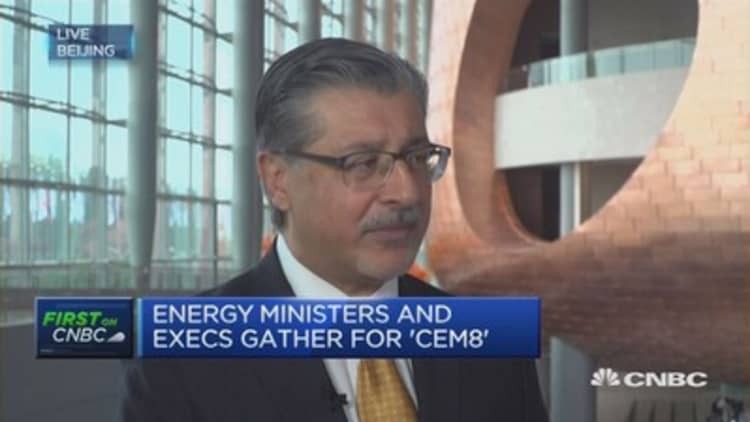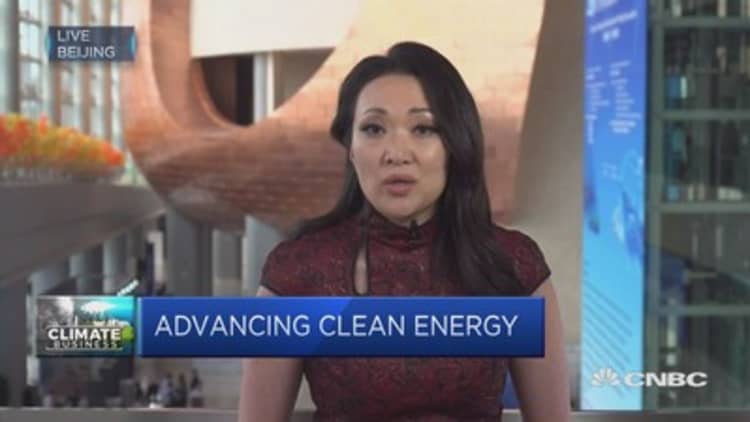
The technologies needed to meet the Paris Agreement's climate goals are not developing quickly enough, according to a new report from the International Energy Agency.
Nearly every country in the world has committed to take action under the Paris Agreement to slow global warming. But only 3 out of 26 technology categories tracked by the IEA are on pace to help do that, the agency concluded in this year's Energy Technology Perspectives report.
The IEA, which advises countries on energy strategy, has a fairly straightforward — if not easy — solution: implement policies that will encourage investment in these technologies and work across borders to develop them.
"Many technology areas suffer from a lack of policy support, and this impedes their scaled-up deployment," IEA said. "Energy efficiency, bioenergy and carbon capture and storage (CCS) are notable examples of where significant potential for technology progress remains, but strong policy signals will be required to trigger the appropriate investments."
The IEA assessment on Tuesday came just days after President Donald Trump announced he would pull the United States out of the Paris Agreement. Trump has already moved to roll back many Obama-era initiatives aimed at mitigating planet-warming emissions, claiming they will hold back economic growth and job creation.
The technology categories that are on track to deliver results — electric vehicles, solar and onshore wind power, and energy storage — have all benefited from government support and clear policies, IEA notes.
But all 26 technology categories need to be developed and deployed in tandem in the coming years in order to ensure energy supply is affordable, secure and sustainable, according to IEA.
On the supply side, IEA said governments need to develop policies that encourage the spread of offshore wind power, nuclear energy and natural gas, while discouraging the continued use of the most inefficient coal-fired technology. It also says technology to capture carbon from power plants and other industrial facilities — so-called carbon capture and storage — needs support in order to encourage large-scale projects.
The agency also urges policies that would help speed along technology that decreases energy demand from industrial facilities, buildings and the transportation sector. Those include policies that cap the amount of carbon companies are allowed to emit. These systems are already used in the European Union and are being developed in China, Mexico and Canada.
Questions over U.S. commitment to green tech
A coalition of American states, cities, businesses and colleges have vowed to take action so the country — the world's second-largest emitter of greenhouse gases — meets its commitments to the Paris Agreement.

While cities and states can certainly reduce their emissions from existing sources, energy technology innovation is a critical part of combating climate change, said Akshaya Jha, a professor at Carnegie Mellon University who specializes in energy and environmental economics.
For every year that new advances fail to hit the market, businesses and states must rely on existing technology. Once a power plant is built or technology is integrated into an industrial facility, it may last for years or decades, creating an entrenched competitor to new green energy technologies, he explained.
"New technologies don't just change the current landscape, they change the landscape potentially for 20, 30, 40 years," Jha told CNBC.
In the United States, the federal government has traditionally underwritten investment in early stage energy technology, but the White House has proposed cutting that spending.
Last month, the Trump administration's 2018 budget slashed $2.3 billion from the Department of Energy's R&D programs — a 54 percent decline from 2016. Offices that will see deep cuts include those responsible for promoting energy efficiency, bringing carbon capture and storage to market, and extending the life of nuclear power plants.

This is despite the United States joining 21 other nations and the European Union in a pledge to double spending on energy research and development in a bid to bring about a clean power revolution. Under a plan the Obama administration submitted in 2015, the U.S. would have raised funding to $6.4 billion by 2021.
This week, all of the countries except the United States reaffirmed or increased their commitments to raise R&D spending at the second Mission Innovation meeting in Beijing.
"United States Mission Innovation activities are currently under review. The U.S. remains committed to prudent investment in early stage R&D that underlies technology breakthroughs," the U.S. delegation led by Energy Secretary Rick Perry said in statement.
— CNBC's John Schoen contributed to this story.


